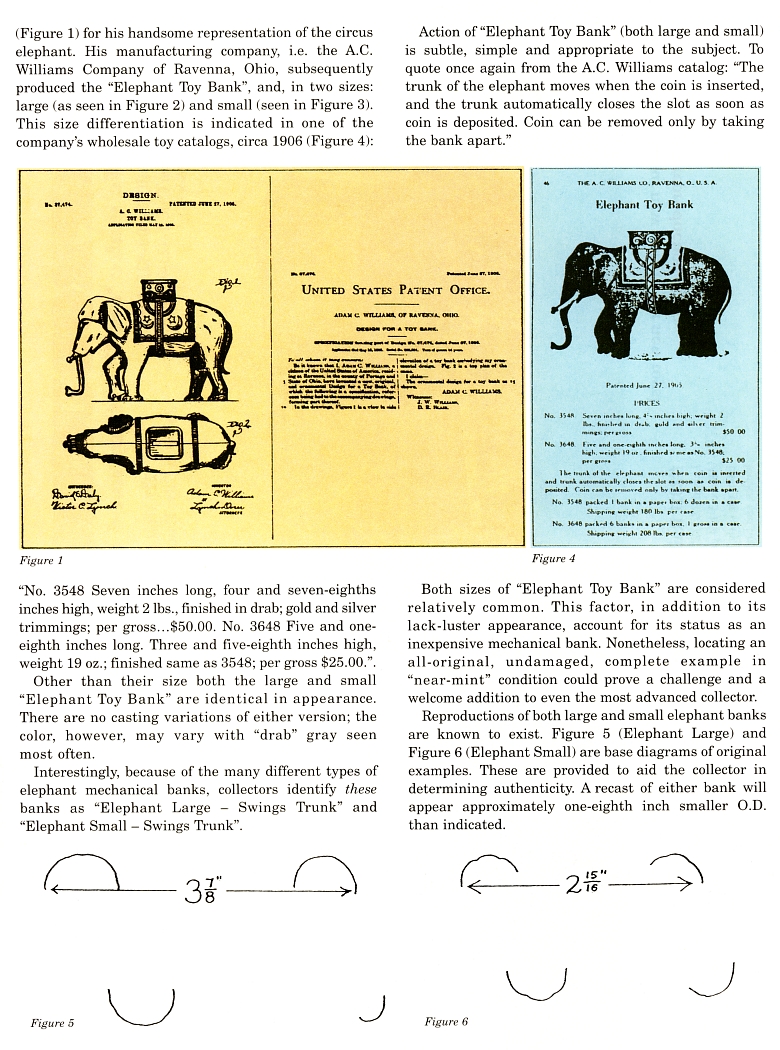|
Elephant Swings Trunk
(Large Variation)
by Sy Schreckinger – ANTIQUE TOY WORLD Magazine – January, 2009
The mid-nineteenth to early twentieth centuries
proved a time of discovery and adventure for the American populous.
Travelers from foreign lands introduced a wealth of unique and exciting
ideas.
Also brought to these shores were strange and exotic animals. Several
of these creatures were feverishly sought after by proprietors of
carnivals and circuses. Their motivation was to feature novel,
never-before-seen, additions to their menageries. Of these, the elephant
may, perhaps, have been one of the most fascinating and endearing to both
children and adults alike. Its huge and mighty appearance belied its
innate gentleness.
Renowned American circus mogul, P.T. Barnum, recognized the ability
of the elephant to perform and attract major audiences. His exhibitions of
one such beast was promoted as "Jumbo, the World's Largest Elephant". This
spectacle drew massive audiences and achieved worldwide acclaim. Jumbo's
likeness adorned such items as posters, packaged foods, clothing, tools
and toys.
Mechanical bank manufacturers also did not hesitate to capitalize on
such a popular and newsworthy subject. Images of the colossal pachyderm
were soon incorporated into their line of wares.
On June 27, 1905, designer Adam C. Williams of Ravenna, Ohio, was
granted Patent number
37,474 (Figure 1) for his handsome representation of
the circus elephant. His manufacturing company, i.e. the A.C. Williams
Company of Ravenna, Ohio, subsequently produced the "Elephant Toy Bank",
and, in two sizes: large (as seen in Figure 2) and small (seen in Figure
3). This size differentiation is indicated in one of the company's
wholesale toy catalogs, circa 1906 (Figure 4): "No. 3548 Seven inches
long, four and seven-eighths inches high, weight 2 lbs., finished in drab;
gold and silver trimmings; per gross...$50.00. No. 3648 Five and one-eighth inches long. Three and five-eighth inches high, weight 19 oz.;
finished same as 3548; per gross $25.00.".
Other than their size both the large and small "Elephant Toy Bank"
are identical in appearance. There are no casting variations of either
version; the color, however, may vary with "drab" gray seen most often.
Interestingly, because of the many different types of elephant
mechanical banks, collectors identify these banks as "Elephant Large —
Swings Trunk" and "Elephant Small — Swings Trunk".
Action of "Elephant Toy Bank" (both large and small) is subtle,
simple and appropriate to the subject. To quote once again from the A.C.
Williams catalog: "The trunk of the elephant moves when the coin is
inserted, and the trunk automatically closes the slot as soon as coin is
deposited. Coin can be removed only by taking the bank apart."
Both sizes of "Elephant Toy Bank" are considered relatively common.
This factor, in addition to its lack-luster appearance, account for its
status as an inexpensive mechanical bank. Nonetheless, locating an
all-original, undamaged, complete example in "near-mint" condition could
prove a challenge and a welcome addition to even the most advanced
collector.
Reproductions of both large and small elephant banks are known to
exist. Figure 5 (Elephant Large) and Figure 6 (Elephant Small) are base
diagrams of original examples. These are provided to aid the collector in
determining authenticity. A recast of either bank will appear
approximately one-eighth inch smaller O.D. than indicated.
|

